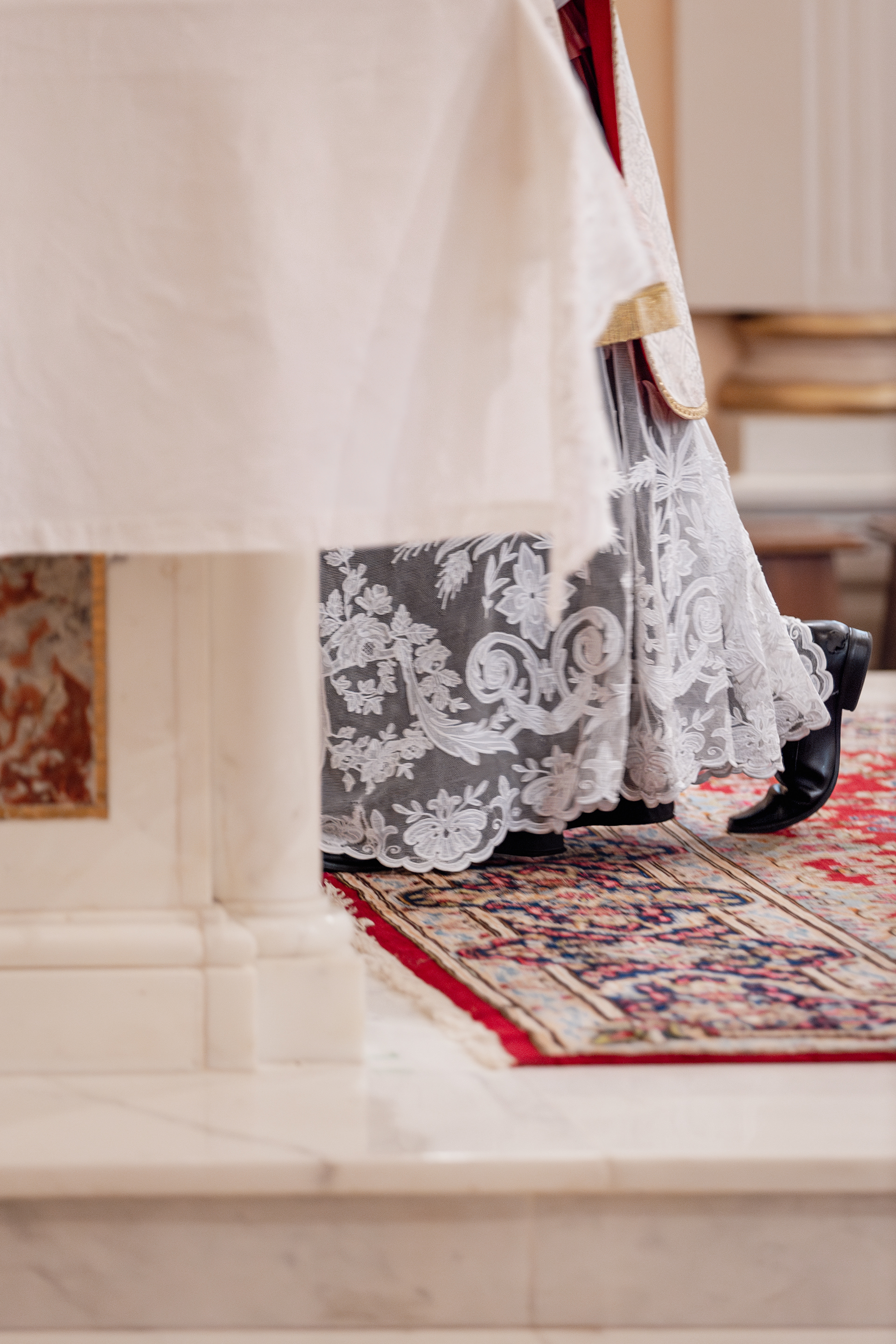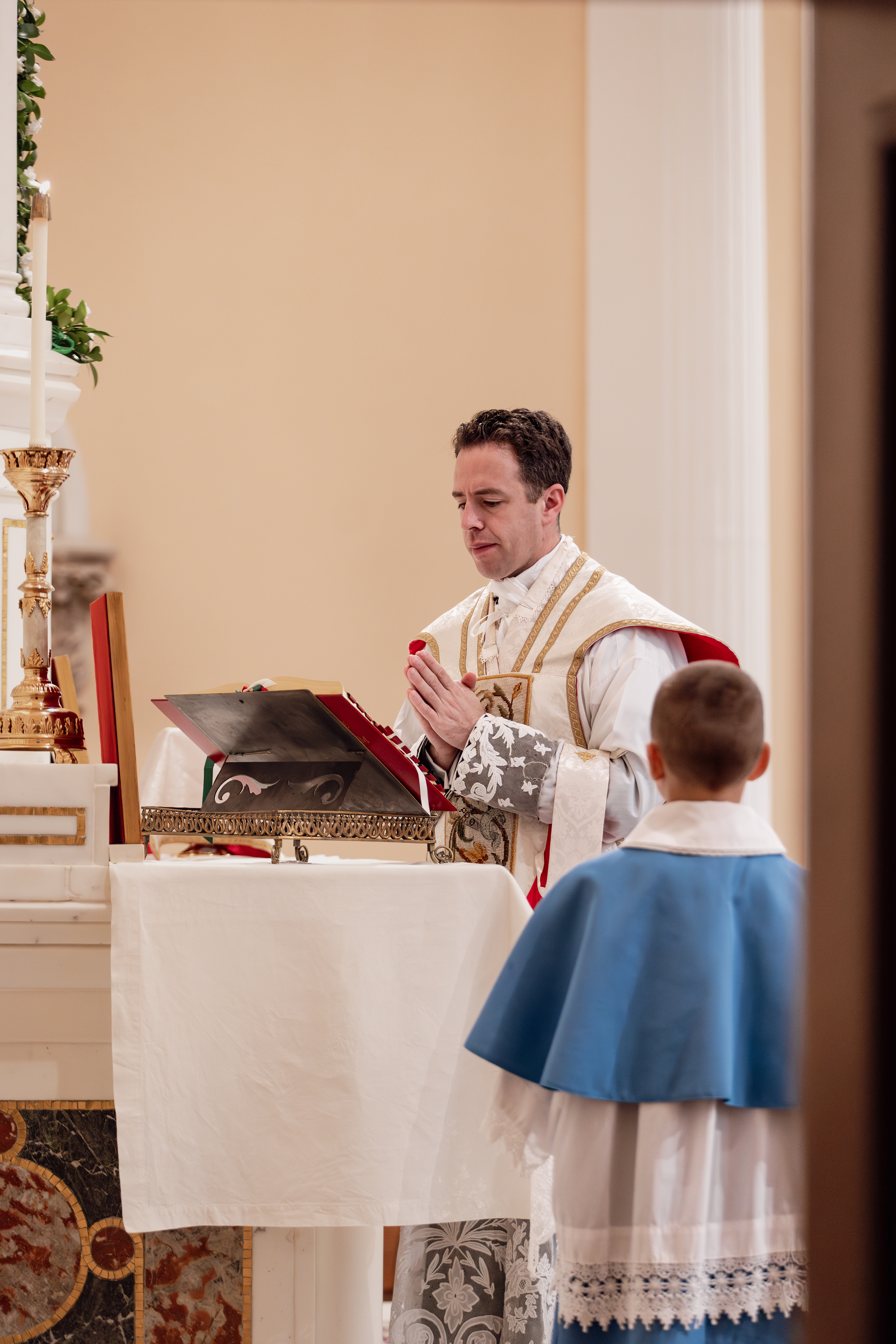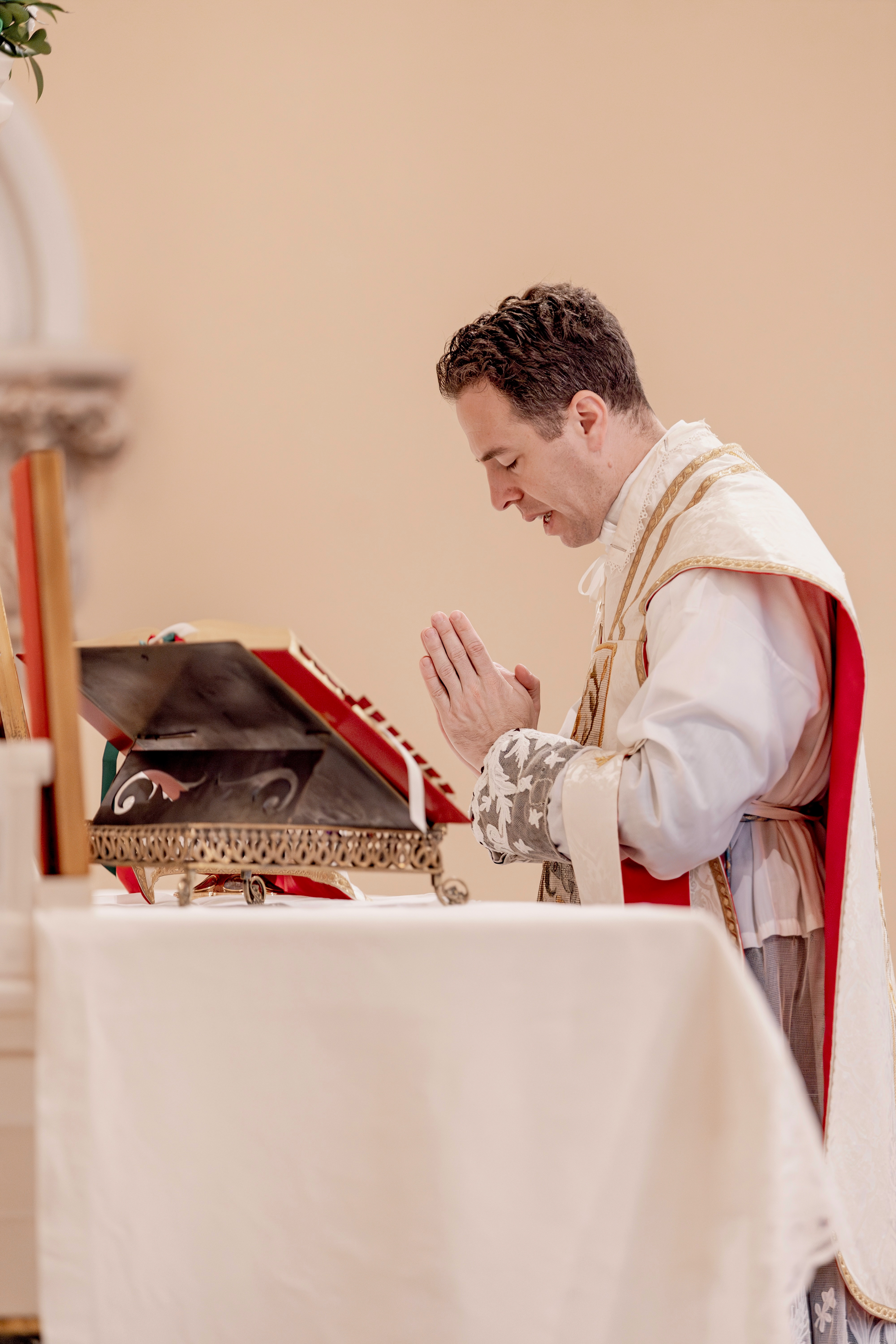Special thanks to Canon M. Stein, ICKSP for granting permission to photograph a Mass in real time and for providing information about many liturgical details. The majority of the photos in this series are from that Mass, which offered on the Feast of the Queenship of the Blessed Virgin Mary.
Where possible, the translations given are the exact equivalent currently used in the Novus Ordo. This choice was made in order to provide a translation that may be more familiar than the one that is found in Latin hand missals, and to highlight how much of the Latin Mass is already familiar to many Catholics. On the whole, the translations in the 2011 revision of the Roman Missal are very faithful to the Latin, with adjustments made for syntax.
In the interest of stylistic consistency, "archaic language" is not used in translations of texts abandoned or significantly changed in the Novus Ordo when the 2011 translation is not applicable. The Latin for dialogues and spoken prayers is always included.
This series covers the entire Mass in the context of a Low Mass. The additional ceremonies of the High Mass and Solemn High Mass will be covered in a separate series.
An altar server rings the sanctuary bell, telling the congregation to stand. The priest, accompanied by up to two servers, enters from the sacristy carrying the altar vessels under the chalice veil and burse. He wears a hat called a biretta, which he hands to the server to set aside. The servers kneel at the foot of the altar as the priest places the chalice on the altar, lays out the corporal, and sets the Missal. When the priest returns to the foot of the altar, he genuflects and the congregation kneels.
The Mass begins with the Sign of the Cross, followed by the Prayers at the Foot of the Altar. They open with an antiphon said in alternation with the servers.
Priest: "Introíbo ad altáre Dei." (I will go unto the altar of God)
Servers: "Ad Deum qui laetíficat juventútem meam." (To God, Who gives joy to my youth.)
Servers: "Ad Deum qui laetíficat juventútem meam." (To God, Who gives joy to my youth.)
The priest recites Psalm 43 (Douay Rheims 42), alternating each line with the altar servers. The Psalm portion ends with the Gloria Patri (Glory Be). The antiphon is repeated.
*Liturgy Note: Psalm 43 is omitted in the Mass for the Dead (All Souls' Day and Requiems) and during Passiontide and Holy Week. During these times, the Prayers at the Foot of the Altar begin with the dialogue below.
Everyone makes the Sign of the Cross.
P: "Adjutórium nóstrum in Nómine Dómini." (Our help is in the Name of the Lord.)
S: "Qui fecit cælum et terram." (Who made heaven and earth.)
Psalm 124 (DR 123):8
S: "Qui fecit cælum et terram." (Who made heaven and earth.)
Psalm 124 (DR 123):8
*Liturgy Note: Depending on the custom of the parish, the congregation may make the responses aloud with the servers.
Bowing deeply, the priest recites the Confiteor. In the Ordinary Form, the Confiteor retains its basic structure but is shortened significantly. The original text is presented here, with variations for the priest and the servers:
"Confíteor Deo omnipoténti, beátae Mariae semper Vírgini, beáto Michaéli Archángelo, beato Ioánni Baptístae, sanctis Apóstolis Petro et Paulo, ómnibus Sanctis, et vobis/tibi, fratres/pater, quia peccávi nimis cogitatióne, verbo et opere: [he strikes his breast three times] mea culpa, mea culpa, mea máxima culpa. Ideo precor beátam Mariam semper Vírginem, beátum Michaélem Archángelum, beatum Ioánnem Baptístam, sanctos Apóstolos Petrum et Paulum, omnes Sanctos, et vos/te, fratres/pater, oráre pro me ad Dóminum Deum nóstrum. Amen."
(I confess to almighty God, to blessed Mary ever Virgin, to blessed Michael the Archangel, to blessed John the Baptist, to the holy apostles Peter and Paul, to all the saints, and to you, brothers/Father, that I have sinned exceedingly in thought, word, and deed, through my fault, through my fault, through my most grievous fault. Therefore, I beseech blessed Mary ever Virgin, blessed Michael the Archangel, blessed John the Baptist, the holy apostles Peter and Paul, all the saints, and you, brothers/Father, to pray for me to the Lord our God. Amen.)
(I confess to almighty God, to blessed Mary ever Virgin, to blessed Michael the Archangel, to blessed John the Baptist, to the holy apostles Peter and Paul, to all the saints, and to you, brothers/Father, that I have sinned exceedingly in thought, word, and deed, through my fault, through my fault, through my most grievous fault. Therefore, I beseech blessed Mary ever Virgin, blessed Michael the Archangel, blessed John the Baptist, the holy apostles Peter and Paul, all the saints, and you, brothers/Father, to pray for me to the Lord our God. Amen.)
*Terminology: The word "rubrics" is taken from the Latin rubrum, meaning red. In the missal, the prayers are printed in black ink and the rubrics - the instructions for the priest's actions - are in red. This is the origin of the phrase "say the black, do the red." When an action directly corresponds with a specific line of a spoken prayer, it will be indicated here in red.
The servers respond, "Misereátur tui omnípotens Deus, et, dimíssis peccátis tuis, perdúcat te ad vitam aetérnam." (May almighty God have mercy upon you, forgive you your sins, and bring you to life everlasting.)
The priest says, "Amen," and stands upright.
The servers bow and make the same confession with and on behalf of the congregation.
*Watch For: The servers turn in toward the priest both times they say, "et te/tibi, pater" (and you, Father). Sometimes the Confiteor can be difficult to hear, and you can use these turns to help you follow.
The priest says the same Misereátur as the servers. The servers kneel upright and everyone makes the Sign of the Cross as the priest gives the absolution.
"Indulgéntiam, + absolutiónem et remissiónem peccatórum nostrórum tríbuat nobis omnípotens et miséricors Dominus."
(May the almighty and merciful Lord grant us pardon, absolution, and remission of our sins.)
(May the almighty and merciful Lord grant us pardon, absolution, and remission of our sins.)
*Liturgy Note: This absolves us of any venial sins we have committed. This absolution is retained - with an altered text - after the Confiteor in the Novus Ordo.
A short dialogue follows.
P: "Deus, tu convérsus vivicábis nos." (You shall turn again, O God, and quicken us.)
S: "Et plebs tua laetábitur in te." (And Your people shall rejoice in You.)
Psalm 85 (DR 84):6
P: "Osténde nobis, Dómine, misericórdiam tuam." (Show us, O Lord, Your mercy.)
S: "Et salutáre tuum da nobis." (And grant us Your salvation.)
Psalm 85 (DR 84): 7
P: "Dómine, exaudi oratiónem meam." (Lord, hear my prayer.)
S: "Et clamor meus ad te veniat." (And let my cry come unto You.)
Psalm 101 (DR 100): 1
S: "Et plebs tua laetábitur in te." (And Your people shall rejoice in You.)
Psalm 85 (DR 84):6
P: "Osténde nobis, Dómine, misericórdiam tuam." (Show us, O Lord, Your mercy.)
S: "Et salutáre tuum da nobis." (And grant us Your salvation.)
Psalm 85 (DR 84): 7
P: "Dómine, exaudi oratiónem meam." (Lord, hear my prayer.)
S: "Et clamor meus ad te veniat." (And let my cry come unto You.)
Psalm 101 (DR 100): 1
P: "Dóminus vobíscum." (The Lord be with you.)
S: "Et cum spiritu tuo." (And with your spirit.)
P: "Orémus." (Let us pray.)
S: "Et cum spiritu tuo." (And with your spirit.)
P: "Orémus." (Let us pray.)


The priest goes up to the altar, praying in a low voice:
Take away from us our iniquities, we beseech You, O Lord, that we may be worthy to enter with pure minds into the Holy of Holies. Through Christ our Lord. Amen.
The altar represents Christ and also contains relics of the saints. The priest kisses it:
We beseech You, O Lord, by the merits of Your saints whose relics are here and of all the saints, that You would vouchsafe to forgive me all my sins. Amen.
*Liturgy Note: When referring to sides of the altar, it is customary to use "right" and "left" as Christ would from the altar Crucifix (like stage directions, opposite the audience's right and left). The terms "Epistle side" and "Gospel side" are used instead, with the Epistle side to the left (our right) and the Gospel side to the right (our left).
At the Epistle side, the priest recites the Introit, the first of the Propers of the Mass. The Propers change with each day. The Introit includes a recitation of the Gloria Patri, during the first half of which the celebrant turns in toward the tabernacle and bows. In the Mass for the Dead and during Passiontide and Holy Week, the Gloria Patri is omitted from any places it is ordinarily recited.
*Liturgy Note: When a Mass or a Sunday has a "name," it is taken from the first word of the Introit. Two of the most familiar are the third Sunday of Advent, called Gaudete ("Gaudete in Domino semper," rejoice in the Lord always) and the fourth Sunday of Lent, called Laetare ("Laetare, Jerusalem," rejoice, Jerusalem). Other examples include the Requiem and the Rorate Mass.
The priest returns to the center of the altar and begins the Kyrie. The Latin Mass has three iterations of each petition of the Kyrie. These nine lines are recited in alternation between the servers and the celebrant, beginning and ending with the celebrant.
P: Kyrie, eleison. (Lord, have mercy.)
S: Kyrie, eleison.
P: Kyrie, eleison.
S: Christe, eleison. (Christ, have mercy.)
P: Christe, eleison.
S: Christe, eleison.
P: Kyrie, eleison.
S: Kyrie, eleison.
P: Kyrie, eleison.
S: Kyrie, eleison.
P: Kyrie, eleison.
S: Christe, eleison. (Christ, have mercy.)
P: Christe, eleison.
S: Christe, eleison.
P: Kyrie, eleison.
S: Kyrie, eleison.
P: Kyrie, eleison.
*Liturgy Note: The Kyrie is the first part of the Ordinary of the Mass, sometimes called the "Mass parts." The text of the Ordinary stays the same from day to day, but not all parts of the Ordinary are always said. The Gloria is not said during Passiontide, during the Mass for the Dead, on Sundays and Ferias of Advent and Lent (days when the Mass for that day of the season overrides the feast of the saint of the day), or on Ferias throughout the year (days when there is not a saint's feast prescribed and a votive Mass is not said). The text of the Agnus Dei (Lamb of God) is altered during the Mass for the Dead and omitted at the Easter Vigil.


The Kyrie goes directly into the Gloria, which is the second part of the Ordinary of the Mass. The priest raises his hands as he begins:
"Gloria in excélsis [he makes an arc, brings his hands in and down, and bows] Deo et in terra pax homínibus bonæ voluntátis..."
(Glory to God in the highest, and on earth peace to people of good will...)
(Glory to God in the highest, and on earth peace to people of good will...)
*Liturgy Note: The recitation of the Gloria is the first solemn thing that happens during the Mass, and it happens at the center of the altar. The Epistle and Gospel sides of the altar represent the Old and New Testaments, respectively. Christ is the center of both Testaments and also the bridge between them. It is therefore fitting that the priest be between the Epistle and Gospel sides as he says the Gloria, the song the angels sang at the birth of Christ.
*Liturgy Note: When the Gloria is not said, the Kyrie goes directly into the actions and dialogue below.
The priest kisses the altar, turns to the people, and extends his hands.
P: "Dóminus vobíscum." (The Lord be with you.)
S: "Et cum spíritu tuo." (And with your spirit.)
S: "Et cum spíritu tuo." (And with your spirit.)
*Liturgy Note: Just as we ought to do when we are having a conversation, the priest faces the One or ones to whom he is speaking. When he is speaking to God, he faces Our Lord in the tabernacle. When he is speaking to the congregation, he turns and faces us.
The priest goes to the Epistle side of the altar. He bows toward the tabernacle, saying, "Orémus," and prays the Collect, the second Proper of the day.
*Terminology: The name Collect comes from the Latin collígere, meaning to gather up, and the purpose of the Collect (call-eckt) is to quite literally collect the intentions of the feast day being celebrated, asking for the intercession of the saint of the day. If there are two feasts or commemorations on the same day, more than one Collect may be said. Some parishes pray an additional Collect for the Pope at almost every Mass. On certain days of the liturgical year, instructions are given that only the Collect prescribed to the feast is to be said, and no additional Collects are said.
Still at the Epistle side, he reads the Epistle. This may be taken from the New Testament, often the writings of St. Paul, or from Acts, the Apocalypse (Revelation), or a book of the Old Testament.
During much of the year, this is followed by the Gradual and the Alleluia. During the Mass for the Dead and during Lent (even on feast days and solemnities) the Alleluia is replaced by a Tract, which is often a passage from the Psalms. During the Easter season, a Paschal Alleluia (two verses with Alleluias) is done instead of the Gradual and Alleluia.
*Terminology: The Gradual takes its name from the Latin gradus, meaning step, as it was from the steps of the pulpit that the Gradual used to be recited.
On certain feasts and solemnities a Sequence is said or sung after the Gradual and Alleluia or Tract. During the Middle Ages, nearly every feast day had a Sequence. Five of these are still used in the Extraordinary Form: Victimae Paschali Laudes for Easter and its Octave, Veni Sancte Spiritus for Pentecost and its Octave, Lauda Sion for Corpus Christi, Stabat Mater for Our Lady of Sorrows, and the Dies Irae during the Mass for the Dead. Only the first three of these are retained in the Novus Ordo.
As one of the servers takes the Missal to the Gospel side, the priest bows deeply at the center of the altar and prays silently:
Cleanse my heart and my lips, O God almighty, Who cleansed the lips of the Prophet Isaiah with a burning coal, and vouchsafe through Your gracious mercy, so to purify me that I may worthily proclaim Your holy Gospel. Through Christ our Lord. Amen.
*Liturgy Note: The Gospel side of the altar is to Christ's right. As the place of honor, the right side is where Jesus is seated beside His Father in Heaven, and it is on the right side of the Word that the Gospel is read during the Mass.

"Dominus vobiscum."

The priest signs the Gospel.

"Sequentia sancti Evangelii..."
The priest makes the Sign of the Cross on the Gospel, and everyone makes the Sign of the Cross on their forehead, lips, and heart.
P: "Sequéntia sancti Evangélii secúndum [Lucam]."
(The continuation of the holy Gospel according to [Luke].)
S: "Gloria tibi, Dómine." (Glory to You, O Lord.)
(The continuation of the holy Gospel according to [Luke].)
S: "Gloria tibi, Dómine." (Glory to You, O Lord.)
The Sign of the Cross over the forehead, lips, and heart is an outward sign of our prayer that Our Lord keeps His Word in our minds, lips, and hearts, and so in our thoughts, words, and deeds.
At the end of the Gospel the servers respond, "Laus tibi, Christe." (Praise to You, Lord Jesus Christ.)
The priest moves the Missal to just off center of the altar. If there is a homily, he will remove the maniple and lay it on the Missal, take off the chasuble, and go to a lectern off the Gospel side. If there is no homily, he begins the Credo, raising his hands as he did during the Gloria.


"Credo in unum [he makes an arc, brings his hands down and in, and bows] Deum, Patrem omnipotentem..."
(I believe in one God, the Father almighty...)
(I believe in one God, the Father almighty...)
Everyone kneels at the words, "Et incarnátus est de Spíritu Sancto ex Maria Vírgine, et homo factus est." (And by the Holy Ghost, [He] was incarnate of the Virgin Mary, and became man.)
*Liturgy Note: The Credo is not said at every weekday Mass. When the Credo is not said, the priest goes directly from the Gospel or homily into the dialogue below.
He kisses the altar and turns to the people.
P: "Dominus vobíscum."
S: "Et cum spiritu tuo."(And with your spirit.)
S: "Et cum spiritu tuo."(And with your spirit.)
He turns to face the altar.
P: "Orémus." (Let us pray.)
*Liturgy Note: This concludes the first half of the Mass, also called the Mass of the Catechumens. In the early Church, catechumens departed before the Offertory as only the baptized soul is able to assist at the Mass of the Faithful, that part of the Mass from the Offertory onward. Today of course, anyone, regardless of baptism status, may attend the Mass in its entirety, but we have retained these titles for the halves of the Mass.